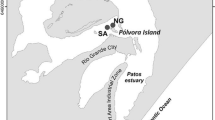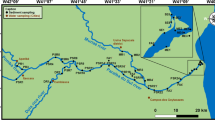Abstract
We investigate the distributions of the metalloid arsenic (As) and metals iron (Fe) and manganese (Mn) in the sediments of two pristine areas of a biological reserve in the Patos Lagoon Estuary. This area is occupied by Spartina alterniflora and by Neohelice granulata crab colonies and low concentrations of As are expected. The bioturbation/bioirrigation of sediments by crabs and the roots of plants lead to the penetration of oxygen below the oxic/suboxix division and the subsequent precipitation of Fe-Mn hydroxides. Ferruginous incrustations and nodules along roots and crab channels propagate to depths of over 35 cm and sediment contains up to 33 mg kg− 1 of As. The metalloid distribution in sediments is strongly correlated with that of Fe but not with Mn. This study revealed that areas with biologically disturbed sediments could demonstrate contamination in As, which is not anthropogenic in origin.

Similar content being viewed by others
References
Alberti J, Daleo P, Iribarne O, Silliman BR, Bertness M (2007) Local and geographic variation in grazing intensity by herbivorous crabs in SW Atlantic salt marshes. Mar Ecol Prog Ser 349:235–243.
Angeletti S, Cervellini PM (2015) Population structure of the burrowing crab Neohelice granulata (Brachyura, Varunidae) in a southwestern Atlantic salt marsh. Lat Am J Aquat Res 43(3):539–547
Bone SE, Gonneea ME, Charette MA (2006) Geochemical cycling of arsenic in a coastal aquifer. Environ Sci Technol 40:3273–3278
Caetano M, Vale C (2002) Retention of arsenic and phosphorus in iron-rich concretions of Tagus salt marshes. Mar Chem 79:261–271
Chaillou G, Schafer J, Anschutz P et al (2003) The behaviour of arsenic in muddy sediments of The Bay of Biscay (France). Geochim Cosmochim Acta 67:2993–3003
CONAMA Ministério do Meio Ambiente, Conselho Nacional do Meio Ambiente. Resolução nº 454, de 01 de novembro de 2012 (in Portuguese).
EPA Method – 3051 (2012) http://www.caslab.com/EPA-Method-3051/ Accessed 21 March 2012
Freitas RF, Schrack EC, Sieg RD, Silliman BR, Costa CSB (2015) Grazing scar characteristics impact degree of fungal facilitation in Spartina alterniflora leaves in a South American salt marsh. Braz Arch Biol Technol 58: 103–108.
Freitas RF, Schrack EC, He Q, Silliman BR, Furlong EB, Telles AC, Costa CSB (2016) Consumer control of the establishment of marsh foundation plants in intertidal mudflats. Mar Ecol Prog Series 547: 79–89.
Hyacinthe C, Anschutz P, Jouanneau JM, Jorissen FJ (2001) Early diagenesis processes in the muddy sediment of the Bay of Biscay. Mar Geol 177:111–128
Leivuori M, Niemistö L (1993) Trace metals in the sediments of the Gulf of Bothnia. Aqua Fenn 23:89–100
Martinetto P, Montemayor DI, Alberti J, Costa CSB, Iribarne O (2016) Crab bioturbation and herbivory may account for variability in carbon sequestration and stocks in south west Atlantic salt marshes. Front Mar Sci 3, 122.
Mirlean N, Andrus VE, Baisch P et al (2003) Arsenic pollution in Patos Lagoon estuarine sediments, Brazil. Mar Pollut Bull 46:1480–1484
Mirlean N, Baisch P, Travassos MP, Nassar C (2011) Calcareous algae bioclast contribution to sediment enrichment by arsenic on the Brazilian subtropical coast. Geo-Mar Lett 31:65–73
Mirlean N, Medeanic S, Garcia FA et al (2012) Arsenic enrichment in shelf and coastal sediment of the Brazilian subtropics. Cont Shelf Res 35:129–136
Pérez-López R, Nieto JM, López-Cascajosa MJ et al (2011) Evaluation of heavy metals and arsenic speciation discharged by the industrial activity on the Tinto-Odiel estuary, SW Spain. Mar Pollut Bull 62:405–411
Sadiq M (1992) Toxic metal chemistry in marine environments. Marcel Dekker, New York
Santos CG, Garcia F, Baisch P, Mirlean N (2009) Relação entre fração fina e total no monitoramento de sedimentos contaminados por metais pesados na região portuária estuarina de Rio Grande. In Farg (Ed), Portos e dragagem, Farg, Fortaleza p 23–25 (in Portuguese)
Widerlund A, Ingri J (1995) Early diagenesis of arsenic in sediments of the Kalix River estuary, northern Sweden. Chem Geol 125:185–196
Acknowledgement
The research was funded by the Brazilian National Research Council (CNPq, Grant 470541/2010-5).
Author information
Authors and Affiliations
Corresponding author
Rights and permissions
About this article
Cite this article
Costa, L., Mirlean, N. & Garcia, F. Arsenic Environmental Threshold Surpass in Estuarine Sediments: Effects of Bioturbation. Bull Environ Contam Toxicol 98, 521–524 (2017). https://doi.org/10.1007/s00128-016-2024-z
Received:
Accepted:
Published:
Issue Date:
DOI: https://doi.org/10.1007/s00128-016-2024-z




